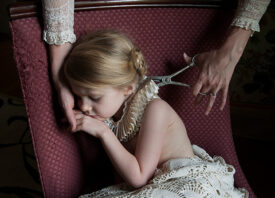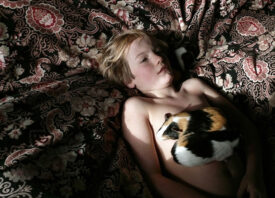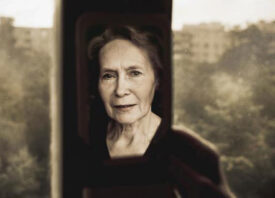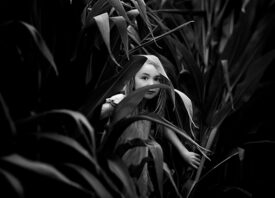Search this site
A Fantastical Sense of Childhood Captured over 6 Years
 Pomponio State Beach
Pomponio State Beach
 Joy Ride, Highway 1
Joy Ride, Highway 1
“Most of the images I have from my own childhood are in my memories; I remember my childhood as being magical and intense. Maybe this influenced my approach to photographing her—a desire to evoke a fantastical sense of childhood.”
For the past six years, California-based photographer Gwen Coyne has been using an iPhone to capture moments of her daughter’s childhood in an aptly named personal project, The Early Years. As a working mother, Gwen explains, she and her daughter have limited time together, yet her existence now forms the basis for her own: “My daughter was hard to come by, she also has asthma and I never know when a mild cold will turn into an emergency.”
In capturing a series of short stories detailing moments of her daughter’s life and the fragility associated with her asthma, the photographer strives to “create images that help remind us of the space and time in between the intensity.” Viewing these images we realize that the classification of this series is not black and white, for it involves a collision between fantasy and documentary. Gwen hopes that over time the series will form a more comprehensive portrait of the early years, while leaving room for her imagination and memory to fill in the gaps.
 Cesar Chavez State Park
Cesar Chavez State Park
How did your daughter feel about you documenting her life for six years?
“In the early years, she wasn’t particularly aware of it; the phone was simply an extension of me. As she gets older, she is more conscious of the camera and my focus on her. At times, she tells me “no more photos”, which I respect. But for the most part, she seems to enjoy the attention.”
Do you feel that your style evolved with time and in correspondence to your daughter’s development?
“Yes, I think I’ve grown with her, because I’m getting restless and am ready for the next step.”
Why did you choose to capture the series with your iPhone?
“The phone is convenient and allows for a less invasive, more immediate response to what’s going on around me. I also see shooting on mobile as being part of something bigger. Mobile photography has reshaped what information is readily accessible, thereby more profoundly impacting how people perceive the world. In sharing glimpses of this tiny person’s life, I feel that I’m contributing to a broader, collective story.”
Do you believe others should contribute to this collective story of humanity via the medium of photography and/or other disciplines?
“Of course; it’s a fascinating cultural movement. Social sharing has disrupted the traditional media outlets. We are hearing from the masses, in addition to the standard channels. This supplemental storytelling helps to eliminate biases and allows for a broader understanding of the human condition.”

Blinded by the light
 Pomponio State Beach
Pomponio State Beach
Did you have a preconceived idea regarding the aesthetic of your images?
“I’m most interested in collecting snippets evocative of her, rather than documenting specifics. Black and white intrinsically supports this separation from reality. Regarding composition, I let the environmental context guide me and I work within it.”
You mentioned you used black and white to distinguish the photographs from reality, did you also have a private photo album to document your daughter’s development?
“I generally reserve colour for higher quality documentation. I do periodically heft out my DSLR so that she’ll know what she actually looked like as a child in a private family album.”
What did the process of creating the images involve?
“I have to get outside on the weekend, as I am in a cubicle environment all week. If I can get out of the house, the rest usually follows. Then I watch and I wait. Sometimes nothing happens, and that’s ok. I try not to force it. The biggest challenge is finding time outside of work to dedicate to photography. It involves being somewhat self absorbed. And that is the hardest part, finding time for myself without alienating my family. This is another advantage of iPhone photography. With the phone, I can carry my darkroom with me, wherever I go.”
Do you think your background in graphic design had any influence on your photography?
“Absolutely, with regards to composition and eliminating unnecessary elements. But I think my background in painting and psychology had a greater influence, with regards to the feeling. In painting, the canvas starts out blank, and gains form as the artist’s interpretation of an idea is impressed upon it, or reconstructed. In psychology, there is a similar concept for individual consciousness: the tabula rasa. I try to approach photography using this “blank slate” philosophy. But with photography, the subject already exists—so it’s up to me to deconstruct and reinterpret it, uniquely.”
What stage is the story currently at and what is next for the story?
“My daughter is beginning to collaborate, which could be interesting. For example, the photo “Hide and seek in the park” was a result of her imagination. Cesar Chavez Park is a wide open space: grass and sky. It would be ludicrous to attempt a game of hide and seek there. She gives me ideas. Who ever knows what will happen next? The future will tell.”
 Hide and seek in the park
Hide and seek in the park
 Abbots State Beach
Abbots State Beach
 Tatou Le Chat
Tatou Le Chat
 Cowell Ranch Beach
Cowell Ranch Beach
 Point Reyes
Point Reyes
All images © Gwen Coyne



